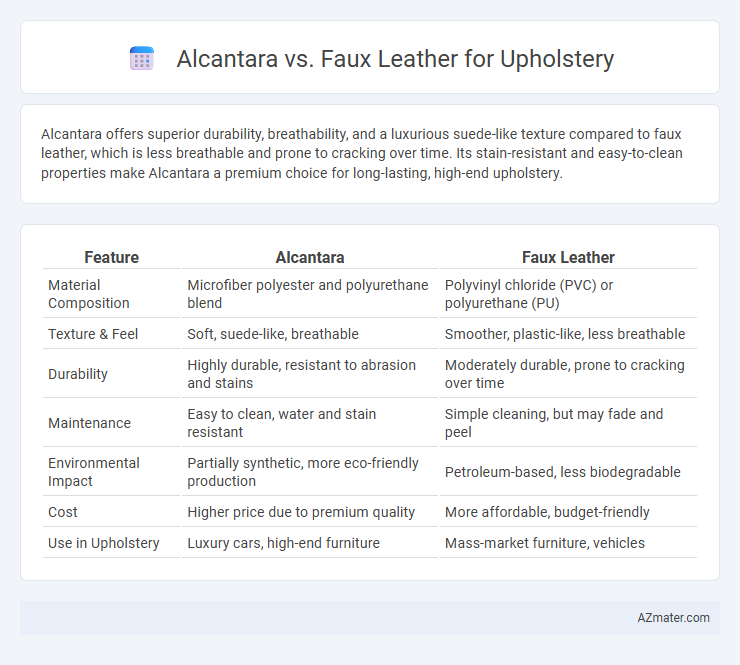Alcantara offers superior durability, breathability, and a luxurious suede-like texture compared to faux leather, which is less breathable and prone to cracking over time. Its stain-resistant and easy-to-clean properties make Alcantara a premium choice for long-lasting, high-end upholstery.
Table of Comparison
| Feature | Alcantara | Faux Leather |
|---|---|---|
| Material Composition | Microfiber polyester and polyurethane blend | Polyvinyl chloride (PVC) or polyurethane (PU) |
| Texture & Feel | Soft, suede-like, breathable | Smoother, plastic-like, less breathable |
| Durability | Highly durable, resistant to abrasion and stains | Moderately durable, prone to cracking over time |
| Maintenance | Easy to clean, water and stain resistant | Simple cleaning, but may fade and peel |
| Environmental Impact | Partially synthetic, more eco-friendly production | Petroleum-based, less biodegradable |
| Cost | Higher price due to premium quality | More affordable, budget-friendly |
| Use in Upholstery | Luxury cars, high-end furniture | Mass-market furniture, vehicles |
Introduction: Understanding Alcantara and Faux Leather
Alcantara is a premium synthetic microfiber fabric known for its durability, softness, and breathable properties, often used in high-end automotive and furniture upholstery. Faux leather, also called synthetic leather or PU leather, mimics the look of genuine leather using polyurethane or PVC materials, offering an affordable and animal-friendly alternative. Both materials provide unique benefits for upholstery, with Alcantara favored for luxury comfort and faux leather prized for easy maintenance and resistance to stains.
Material Composition: What Sets Them Apart
Alcantara is a premium upholstery fabric composed of approximately 68% polyester and 32% polyurethane, offering a soft, suede-like texture with high durability and breathability. Faux leather, primarily made from synthetic materials like polyvinyl chloride (PVC) or polyurethane (PU), mimics the look of genuine leather but often lacks the same level of comfort and breathability as Alcantara. The distinct material compositions influence factors such as maintenance, aesthetics, and longevity, making Alcantara ideal for luxurious, breathable seating and faux leather suitable for cost-effective, easy-to-clean applications.
Appearance and Texture Comparison
Alcantara features a luxurious, suede-like texture with a soft, matte finish that offers a sophisticated and premium appearance ideal for high-end upholstery. Faux leather mimics genuine leather's smooth, glossy look but often appears less natural with a plastic-like texture that can feel less breathable and rigid. The rich tactile experience of Alcantara provides enhanced comfort and elegance, while faux leather delivers a more uniform surface that is easier to clean but may lack the depth and warmth of Alcantara's texture.
Durability and Longevity Analysis
Alcantara outperforms faux leather in upholstery durability due to its high resistance to abrasion, pilling, and fading, making it ideal for heavy-use environments. Faux leather often shows signs of cracking and peeling over time, especially in high-traffic areas, reducing its longevity. The sustained structural integrity and stain resistance of Alcantara contribute to its longer lifespan compared to synthetic leather alternatives.
Comfort and Sensory Experience
Alcantara offers superior softness and breathability compared to faux leather, providing a plush, suede-like texture that enhances comfort in upholstery applications. Its moisture-wicking properties prevent overheating, making it ideal for prolonged seating experiences. Faux leather, while easier to clean and more resistant to spills, lacks the natural warmth and tactile depth of Alcantara, often feeling less inviting and colder to the touch.
Maintenance and Cleaning Requirements
Alcantara requires gentle cleaning with mild soap and water, avoiding harsh chemicals to maintain its soft texture and vibrant color, making it ideal for regular upkeep in upholstery. Faux leather is more resistant to stains and can be cleaned easily with a damp cloth and standard household cleaners, but it may crack or peel over time if not properly maintained. Choosing between Alcantara and faux leather depends on the desired balance between luxurious feel and low-maintenance durability for upholstery applications.
Environmental Impact and Sustainability
Alcantara, a high-performance microfiber fabric, offers greater sustainability compared to faux leather by utilizing a blend of natural and synthetic fibers that require less water and chemicals during production. Faux leather typically relies on PVC or polyurethane, which involve energy-intensive manufacturing processes and emit harmful pollutants, making it less environmentally friendly. Choosing Alcantara for upholstery supports reduced carbon footprints and enhanced biodegradability, aligning with eco-conscious interior design trends.
Cost Differences and Budget Considerations
Alcantara typically costs between $100 and $150 per yard, making it a premium choice compared to faux leather, which ranges from $15 to $40 per yard. Budget considerations favor faux leather for large projects or cost-sensitive applications due to its affordability and durability. Alcantara offers a luxury feel and superior breathability but may require a higher upfront investment, impacting the overall upholstery budget significantly.
Ideal Uses: Where Each Material Excels
Alcantara is ideal for high-end automotive seats, luxury furniture, and designer interiors due to its soft texture, durability, and stain resistance. Faux leather excels in budget-friendly upholstery, pet-friendly environments, and commercial spaces because of its easy maintenance, water resistance, and wide range of color options. Choosing between Alcantara and faux leather depends on desired comfort, budget constraints, and usage conditions.
Final Verdict: Choosing the Right Upholstery Material
Alcantara offers superior breathability, durability, and a luxurious feel, making it ideal for high-end upholstery that demands comfort and longevity. Faux leather provides a cost-effective, easy-to-clean alternative with a similar aesthetic but may lack the same level of softness and temperature regulation. The final verdict depends on balancing budget constraints with desired performance and tactile qualities for the intended upholstery use.

Infographic: Alcantara vs Faux Leather for Upholstery
 azmater.com
azmater.com